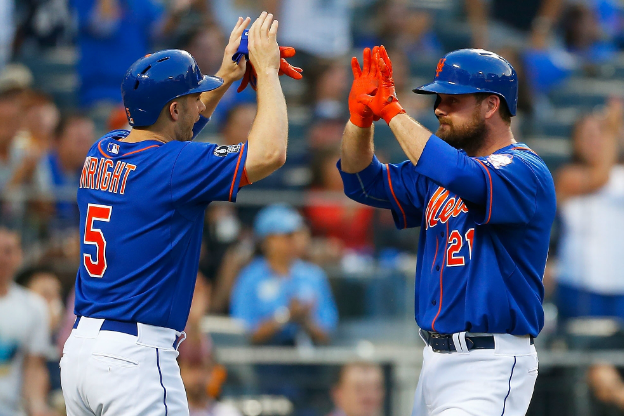
The Mets rode into the All-Star break on an 8-2 roll as the hottest team in the National League. The eyeball test tells us the same thing that the score sheet is telling us – this is a much improved team and the offense is now clicking right along with the pitching.
So what’s the biggest difference between the team we’ve been seeing over the last 10 games and the team we saw over the previous 85? Have they been more selective at the plate? Have they completely changed their hitting philosophy? Have they abandoned the “thou shalt walk” on base mentality? Was it the hitting coach? Is there anything that jumps out that correlates to the increased run production?
The answer is YES. The answer is CONTACT.
I went through the box scores and segmented the season into games 1-25, 26-50, 51-75, and segmented the most part of the season into 10 game segments for games 76-85 and their recent hot streak of games 86-95. The numbers were averaged out the numbers per nine innings. This is what I’ve found…
The offense has improved as of late, which we all know.
Runs Per 9 Innings:
Games 1-25 – 3.9
26-50 – 3.8
51-75 – 3.4
76-85 – 4.6
Average games 1-85 – 3.8
86-95 – 5.8
The offense has definitely improved over the last 20 games.
The eyes are telling me that they’re being much more aggressive at the plate. I guess they’re not working the count as much as they were before, right?
Wrong. The number of pitches per plate appearances has hardly changed.
Pitches Per Plate Appearances:
Games 1-25 – 3.9 pitches per at bat
26-50 – 3.9
51-75 – 4.0
76-85 – 3.9
86-95 – 3.8
One of the principals of Moneyball is because outs are finite, they should be avoided and the goal should be to get players on base to keep the line moving. The more plate appearances per nine innings, the better the line is moving. How have the Mets been at moving the line? The team’s been better at moving the line the last 10 games, for sure.
Plate Appearances Per Nine Innings:
Games 1-25 – 37.7
26-50 – 38.4
51-75 – 37.6
76-85 – 38.1
Average games 1-85 – 37.9
86-95 – 40.1
So what have they been doing differently as they’ve been moving the line more efficiently the last 10 games? They’re taking just as many pitches per at bat. Their offensive production has jumped. Something has to have changed.
Strikeouts have gone down. They’re making contact. When you put the ball in play, things happen. A strikeout isn’t just another out. It makes a difference in moving the lineup.
Percentage of plate appearances resulting in strikeouts:
Games 1-25 – 24.4%
26-50 – 19.5%
51-75 – 21.3%
76-85 – 22.1%
Average games 1-85 – 21.8%
86-95 – 15.1%
During their most recent stretch, the Mets have reduced their strikeouts by 6.7%. By making more contact and putting the ball into play, they’ve improved lineup movement by 5.8% and increased run production by 52.6%.
By making more contact and moving the lineup, they’ve managed to increase run production by that much? Sure. Base hits don’t just move runners station to station. Runners advance an extra base on a single. Extra base hits score runs. Even sacrifice bunts and sacrifice flys move runners over and situational hitting to get the runner over creates productive outs. How have hits per nine innings changed?
Hits Per Nine Innings:
Games 1-25 – 7.2
26-50 – 8.9
51-75 – 7.1
76-85 – 10.2
Games 1-85 – 8.0
86-95 – 9.7
Run per nine innings jumped at the same time that base hits increased. Lineup movement improved and run production improved. Base hits per nine improved and run production improved.
Let’s even take it one step further – how has at bats resulting in contact correlated with run production?
Percentage of at-bats ending in contact (neither a strikeout or walk) versus runs per nine innings:
Games 1-25 – 66.4% contact vs. 3.9 runs/9 innings
26-50 – 72.5% contact vs. 3.8 runs
51-75 – 67.3% contact vs 3.4 runs
76-85 – 73.2% contact vs. 4.6 runs
86-95 – 74.8% contact vs. 5.8 runs
One other interesting observation:
Plate appearances per nine innings and contact rates were very similar for games 26-50 as it was for games 76-85, yet run production was higher in games 76-85. The lineup was moving, but not generating runs as efficiently.
Overall contact rates were similar for both periods. What was the difference? The lineup was more efficient generating runs through hits than walks. They created more hits in games 76-85 (10.2 versus 8.9) with fewer walks (1.8 per nine vs. 3.1 per nine for games 26-50).
There’s nothing wrong with being selective and waiting for your pitch. Just put it in play and make contact. Numbers don’t need to be crunched for our eyes to tell us that. Good things will happen. We’re not that far off.














